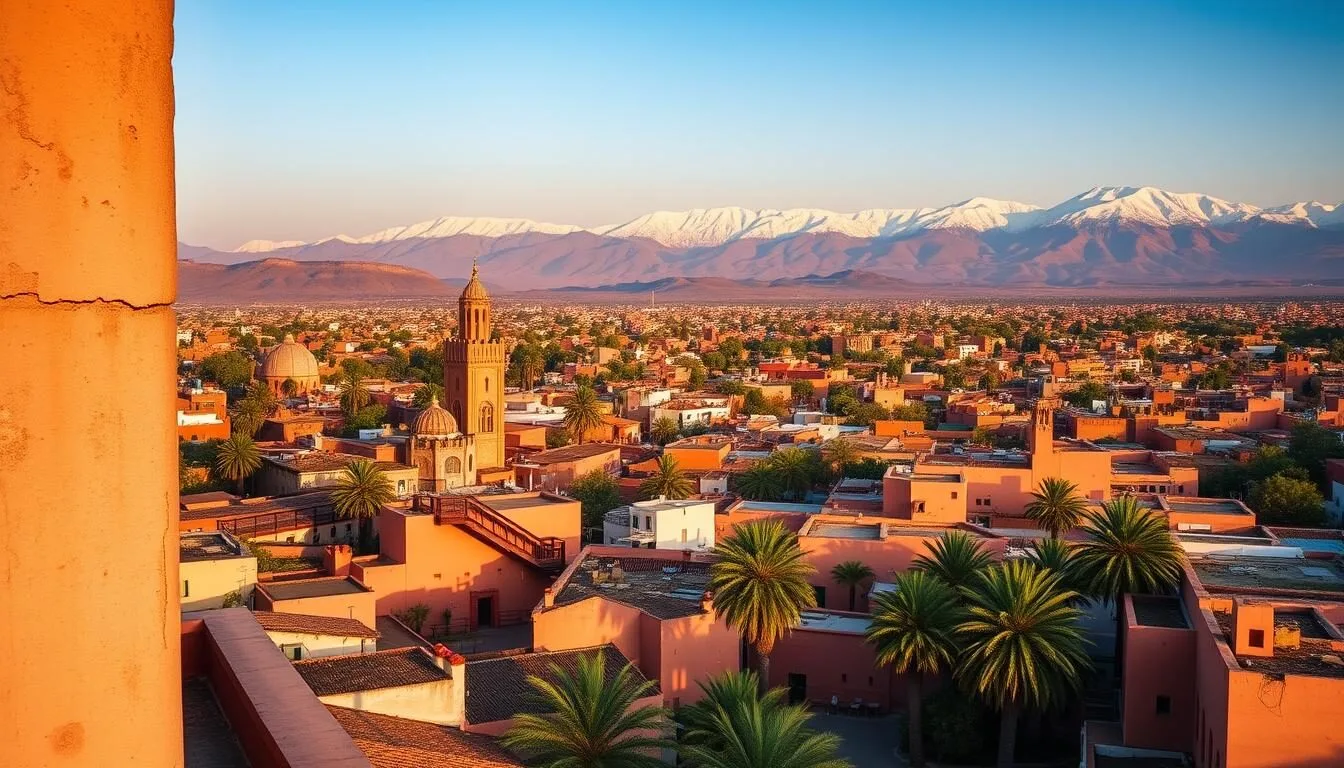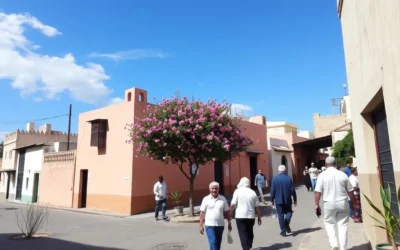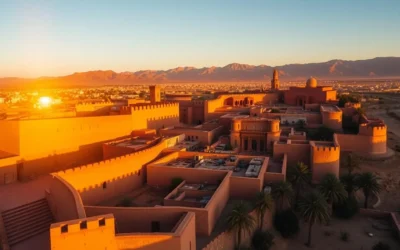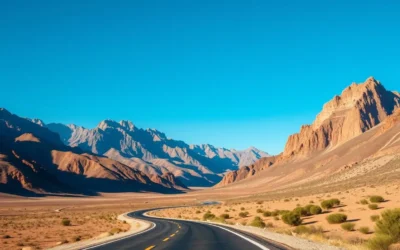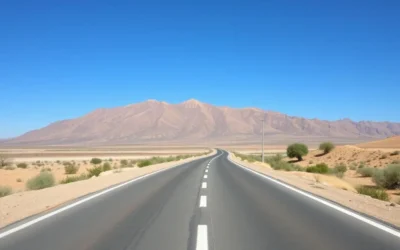Did you know Morocco is one of only three countries in the world where the Mediterranean Sea meets the Atlantic Ocean? This North African gem attracts over 13 million visitors annually who come to experience its mesmerizing blend of ancient medinas, towering mountains, and golden desert landscapes. From getting lost in labyrinthine souks to camping under Saharan stars, Morocco offers experiences that awaken all your senses and create memories that last a lifetime.
Planning Your Journey to Morocco
Marrakech with the Atlas Mountains in the background
Morocco’s diverse landscapes and rich cultural heritage make it a destination that requires thoughtful planning. Whether you’re drawn to the bustling medinas of Marrakech and Fez, the blue streets of Chefchaouen, or the vast Sahara Desert, having a well-structured itinerary will help you make the most of your Moroccan adventure.
Getting There
Most international travelers arrive in Morocco through Casablanca’s Mohammed V International Airport or Marrakech Menara Airport. Several major airlines offer direct flights from Europe, the Middle East, and limited direct options from North America. For the best deals on flights to Morocco, compare options across multiple airlines.
Find Your Flight to Morocco
Start your Moroccan adventure by securing the best flight deals available.
Entry Requirements
Visitors from many countries, including the United States, Canada, and European Union nations, can enter Morocco visa-free for stays up to 90 days. Always check the latest entry requirements before traveling, as regulations may change. You’ll need a passport valid for at least six months beyond your planned departure date.
Best Time to Visit Morocco
Morocco experiences distinct seasonal variations that can significantly impact your travel experience:
Spring (March to May)
Spring offers ideal weather conditions across Morocco. Temperatures are pleasant, ranging from 65°F to 82°F (18°C to 28°C), and the landscapes bloom with wildflowers. This is perfect for exploring cities, hiking in the Atlas Mountains, and enjoying desert excursions without extreme heat.
Fall (September to November)
Like spring, autumn provides comfortable temperatures and clear skies. The summer crowds have dispersed, and you can enjoy Morocco’s attractions with fewer tourists. This period is excellent for photography as the light is particularly beautiful across the diverse landscapes.
Summer (June to August)
Summers can be extremely hot, especially in inland cities like Marrakech and Fez, where temperatures regularly exceed 100°F (38°C). The Sahara Desert becomes nearly unbearable. However, coastal cities like Essaouira and Tangier offer relief with cooler Atlantic breezes.
Winter (December to February)
Winter brings mild temperatures to the coast and cities, but nights can be quite cold, especially in the desert and mountains. The High Atlas Mountains receive snowfall, making this a unique time to witness Morocco’s diverse climate. This is also the wettest season, though rainfall remains relatively limited.
Local Tip: If you’re planning to visit during Ramadan, be aware that business hours may be reduced, and some restaurants may only open after sunset. However, experiencing Morocco during this important religious period offers unique cultural insights.
Getting Around Morocco
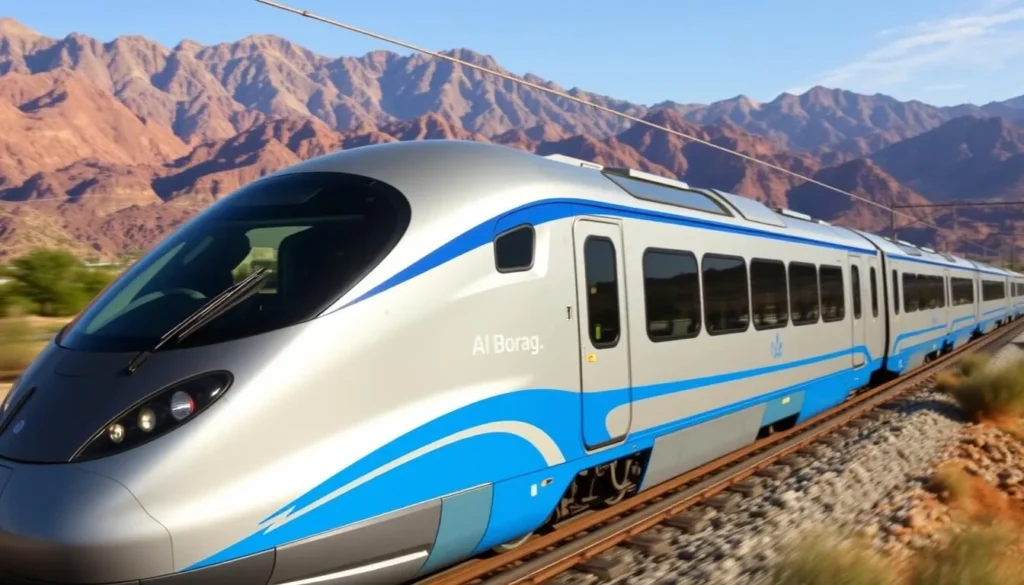
Morocco’s high-speed Al Boraq train connecting major cities
Morocco offers various transportation options to suit different travel styles and budgets:
Trains
Morocco boasts North Africa’s first high-speed train, Al Boraq, connecting Tangier, Rabat, and Casablanca in just over two hours. The national rail network (ONCF) is reliable, comfortable, and connects major cities. First and second-class options are available, with first-class offering assigned seating.
Rental Cars
Renting a car gives you the freedom to explore Morocco at your own pace, especially for reaching remote areas like the Sahara Desert or Atlas Mountains. Roads between major cities are generally well-maintained, though driving in medinas is not recommended. An International Driving Permit is required alongside your regular license.
Explore Morocco at Your Own Pace
Rent a car to discover hidden gems and travel on your own schedule.
Grand Taxis
These shared Mercedes taxis operate between cities and towns, departing when full (usually six passengers). They’re more affordable than private transportation but less comfortable for longer journeys. Negotiate the fare before departing, especially if you want to pay for extra seats for more comfort.
Buses
CTM and Supratours operate comfortable, air-conditioned buses connecting cities and towns throughout Morocco. These are affordable options for intercity travel, with CTM generally offering higher quality service. Booking in advance is recommended, especially during peak tourist seasons.
Where to Stay in Morocco
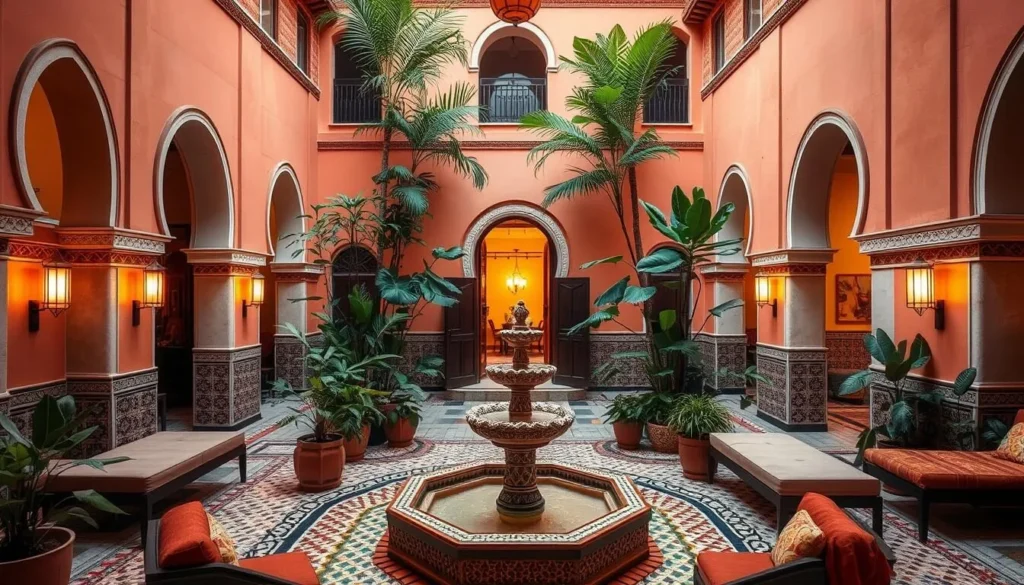
Traditional Moroccan riad with central courtyard and fountain
Morocco offers diverse accommodation options to suit every budget and travel style:
Riads
For an authentic Moroccan experience, stay in a riad – a traditional house with an interior garden or courtyard. These architectural gems have been converted into boutique hotels, offering a peaceful retreat from the bustling medinas. Each riad is unique, often featuring stunning Moroccan craftsmanship, including intricate tilework, carved wood, and stucco designs.
Desert Camps
When visiting the Sahara, spend at least one night in a desert camp. Options range from basic Berber tents to luxury camps with proper beds and private bathrooms. Falling asleep under the star-filled Saharan sky is an unforgettable experience that shouldn’t be missed.
Hotels and Resorts
Major cities and tourist destinations offer international hotel chains and luxury resorts, particularly in Marrakech, Casablanca, and Agadir. These provide familiar comforts and amenities, including swimming pools, restaurants, and spas.
Find Your Perfect Moroccan Accommodation
From authentic riads to luxury desert camps, find the perfect place to stay in Morocco.
Kasbahs
In southern Morocco, particularly along the ancient caravan routes, you can stay in restored kasbahs (fortified houses). These mud-brick structures offer a glimpse into Morocco’s historical architecture while providing comfortable accommodations in stunning settings.
Top Attractions and Experiences in Morocco
1. Explore Ancient Medinas
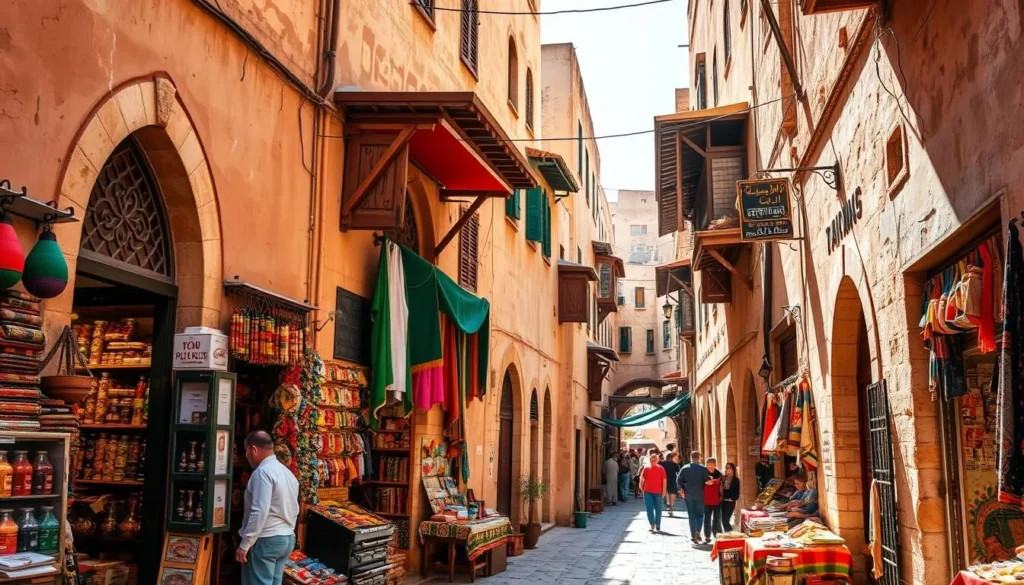
The ancient medina of Fez with its labyrinthine streets and vibrant souks
Morocco’s ancient medinas are the beating heart of its cities, offering a sensory journey through time. The medinas of Fez, Marrakech, and Chefchaouen are UNESCO World Heritage sites, each with its own distinct character:
Fez Medina
Dating back to the 8th century, Fez el Bali is the world’s largest car-free urban area and home to the oldest continuously operating university. Getting lost in its 9,000+ narrow alleyways is part of the experience. Don’t miss the iconic Chouara Tanneries, where leather has been dyed using medieval techniques for centuries.
Marrakech Medina
The Red City’s medina centers around Jemaa el-Fnaa square, which transforms from a daytime market to an evening carnival of storytellers, musicians, and food stalls. Explore the souks selling everything from spices to handcrafted lanterns, and visit architectural treasures like the Bahia Palace and Koutoubia Mosque.
Chefchaouen Medina
Nestled in the Rif Mountains, Chefchaouen’s medina is famous for its striking blue-washed buildings. The peaceful atmosphere and picturesque streets make it perfect for wandering and photography. The blue color, originally introduced by Jewish refugees in the 1930s, now defines this charming town.
Experience Morocco’s Magical Medinas
Discover the ancient cities with expert local guides who can reveal hidden gems and share cultural insights.
Book Guided Tours
2. Journey to the Sahara Desert
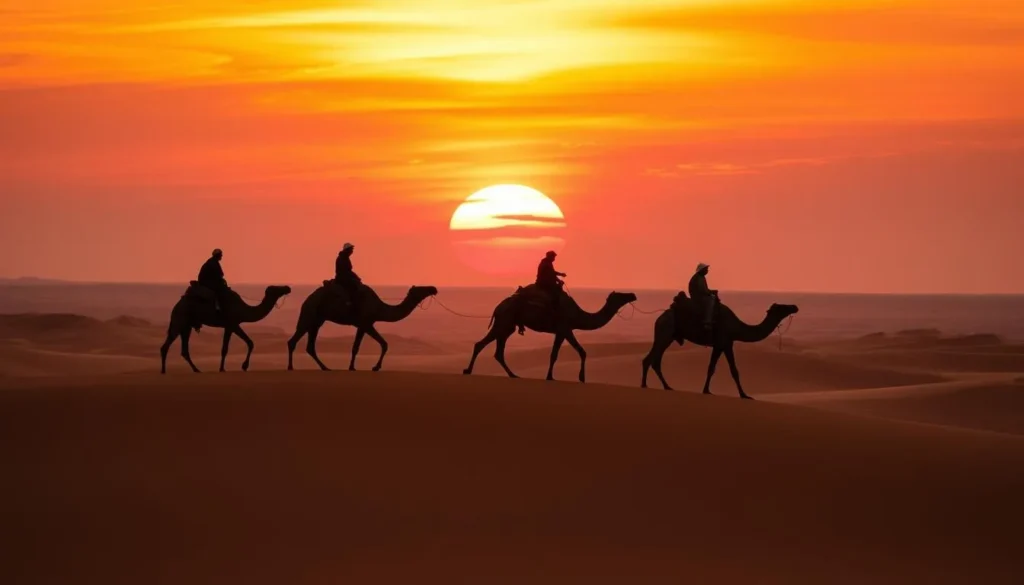
Camel caravan crossing the golden sand dunes of Erg Chebbi at sunset
No visit to Morocco is complete without experiencing the magical Sahara Desert. The two main access points are Merzouga (for Erg Chebbi dunes) and M’Hamid (for Erg Chigaga dunes):
Erg Chebbi
Located near Merzouga, these spectacular orange-hued dunes rise up to 150 meters high. A camel trek takes you deep into the desert to camps where you can experience Berber hospitality, traditional music around the campfire, and stargazing under the clear desert sky.
Erg Chigaga
More remote and less visited than Erg Chebbi, these vast dunes offer a more authentic desert experience. Accessible from M’Hamid, Erg Chigaga requires a 4×4 journey or longer camel trek, but rewards visitors with pristine dunes and profound silence.
Desert Tip: The best times to visit the Sahara are spring (March-May) and fall (September-November). Summer temperatures can exceed 120°F (49°C), while winter nights can drop below freezing. Pack layers regardless of when you visit, as desert temperature fluctuations between day and night are significant.
3. Hike the Atlas Mountains
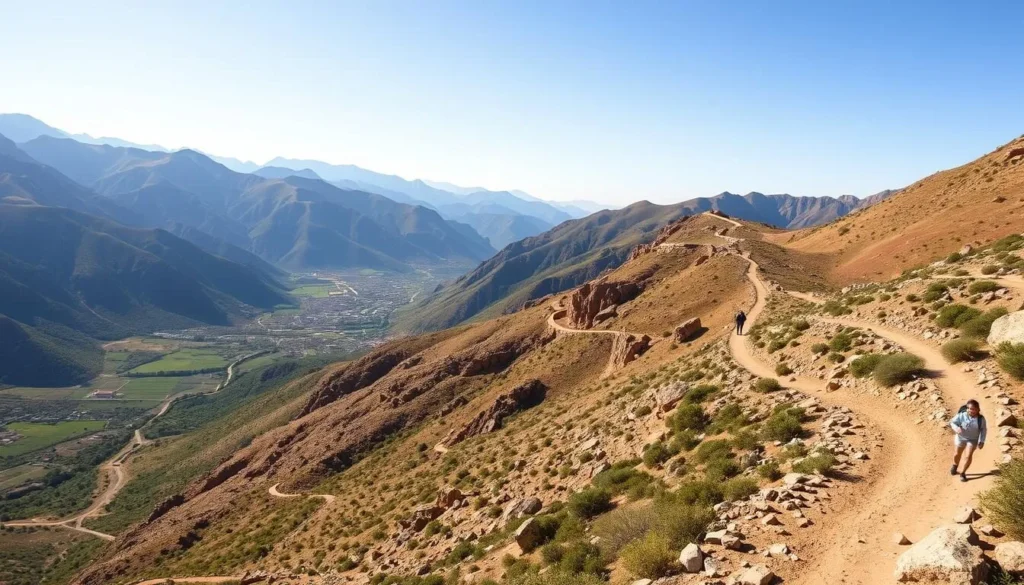
Hiking trail in the High Atlas Mountains with traditional Berber villages below
The Atlas Mountains stretch across Morocco, offering spectacular hiking opportunities and a glimpse into traditional Berber culture:
Mount Toubkal
North Africa’s highest peak (4,167m/13,671ft) is a challenging but rewarding two-day trek from the village of Imlil. The summit offers breathtaking views across the mountains and, on clear days, all the way to the Sahara Desert. Guides are recommended and can be arranged in Imlil.
Todra Gorge
This dramatic canyon features limestone cliffs rising 300 meters on either side of a narrow corridor, with a crystal-clear river running through it. Popular with rock climbers, it also offers excellent hiking opportunities through surrounding valleys and Berber villages.
Ourika Valley
Just an hour from Marrakech, this lush valley offers an accessible taste of mountain life. Visit traditional Berber homes, see how argan oil is produced, and hike to the seven-tiered Setti Fatma waterfalls for a refreshing escape from the city heat.
Adventure Awaits in the Atlas Mountains
Book guided hiking tours, mountain excursions, and authentic cultural experiences.
Explore Mountain Tours
Explore Morocco’s Coastal Charm
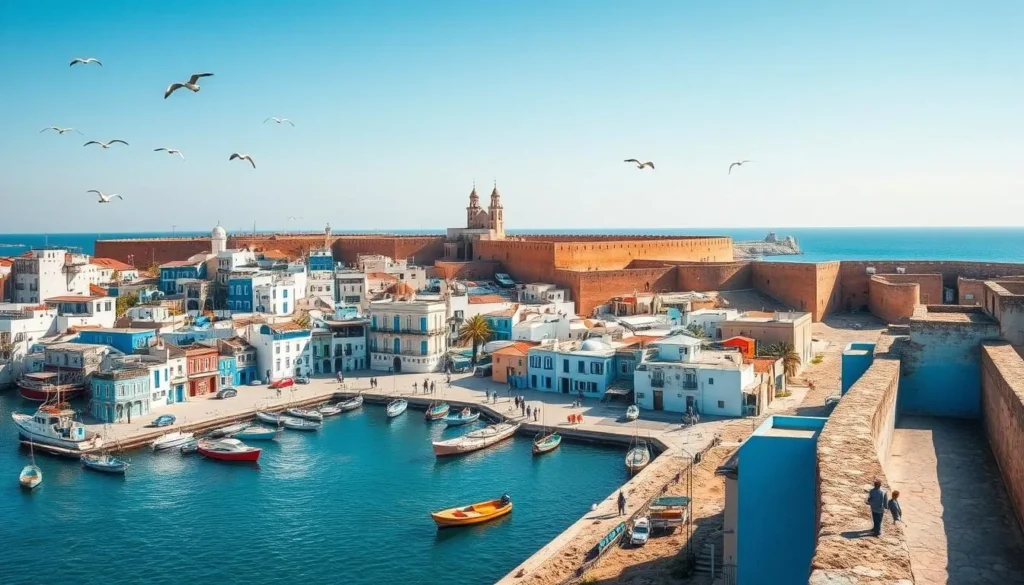
The blue and white buildings of Essaouira’s medina with the Atlantic Ocean
Morocco’s 1,200-mile coastline offers a refreshing contrast to its inland cities and desert landscapes:
Essaouira
This laid-back coastal town combines history, culture, and beach life. Its UNESCO-listed medina features blue and white buildings, art galleries, and seafood restaurants. Known as the “Wind City of Africa,” Essaouira attracts windsurfers and kitesurfers from around the world. The annual Gnaoua World Music Festival in June showcases traditional and contemporary music.
Tangier
Sitting at the crossroads of Europe and Africa, Tangier has long attracted artists, writers, and musicians. Explore the Kasbah overlooking the Strait of Gibraltar, wander through the medina, and visit the American Legation Museum. The Caves of Hercules, just outside the city, offer a fascinating natural and historical site with views of the Atlantic Ocean.
Agadir
Rebuilt after a devastating earthquake in 1960, Agadir is Morocco’s premier beach resort. Its 6-mile golden sand beach, modern infrastructure, and year-round sunshine make it popular with sun-seekers. The nearby fishing villages of Taghazout and Tamraght have become surfing hotspots with waves suitable for all levels.
Immersive Cultural Experiences
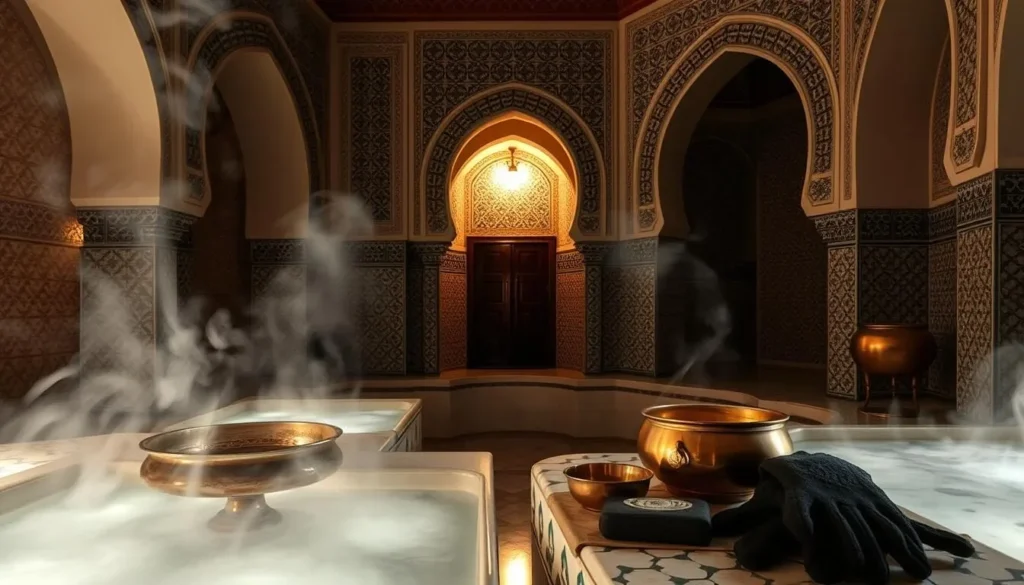
Traditional Moroccan hammam with ornate tilework and steam room
Beyond sightseeing, Morocco offers rich cultural experiences that engage all your senses:
Visit a Traditional Hammam
The Moroccan hammam (public bathhouse) is a centuries-old tradition and social institution. Experience the ritual cleansing process: steaming, scrubbing with black soap, and massage. Options range from local neighborhood hammams (segregated by gender) to luxurious spa versions in riads and hotels.
Learn to Cook Moroccan Cuisine
Moroccan cuisine is a delicious blend of Berber, Arabic, Andalusian, and Mediterranean influences. Cooking classes in Marrakech, Fez, and other cities teach you to prepare classic dishes like tagine, couscous, and pastilla. Many classes include a market visit to select fresh ingredients.
Experience Traditional Music
Morocco’s musical traditions are diverse, from the hypnotic rhythms of Gnaoua (brought north by sub-Saharan enslaved people) to the spiritual Andalusian orchestras and Berber folk music. Attend a performance or one of Morocco’s many music festivals, such as the Fez Festival of World Sacred Music or Essaouira’s Gnaoua Festival.
Discover Authentic Moroccan Experiences
From cooking classes to musical performances, immerse yourself in Morocco’s rich cultural traditions.
Book Cultural Activities
Explore Morocco’s Rich History
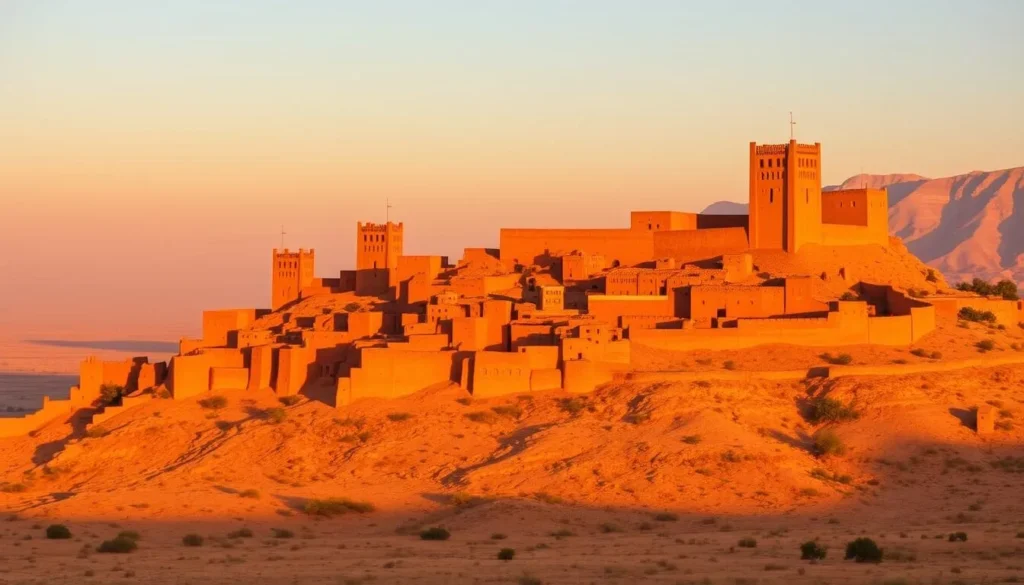
The ancient ksar of Ait Ben Haddou at sunset
Morocco’s strategic location has made it a crossroads of civilizations for millennia, leaving behind fascinating historical sites:
Volubilis
These well-preserved Roman ruins near Meknes date back to the 3rd century BCE. Marvel at the remarkably intact mosaics, triumphal arch, and basilica. The site offers insights into daily life in this once-thriving Roman provincial capital, with informative placards explaining the historical context.
Ait Ben Haddou
This spectacular fortified village (ksar) is one of Morocco’s most iconic sights and a UNESCO World Heritage site. Built along an ancient caravan route, its mud-brick kasbahs have featured in numerous films, including “Gladiator” and “Game of Thrones.” Visit early morning or late afternoon for the best light and fewer crowds.
Kasbah Taourirt
Located in Ouarzazate, this impressive 19th-century kasbah once housed the powerful Glaoui family. Its maze of passageways, rooms, and towers offers a glimpse into traditional Moroccan architecture and the life of Morocco’s ruling class before French colonization.
Shopping in Morocco’s Vibrant Markets
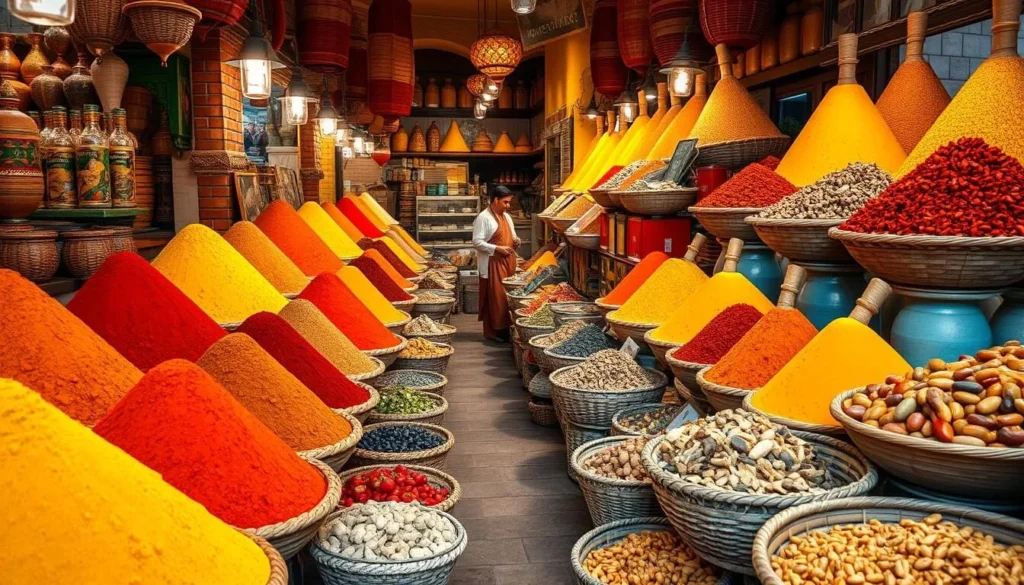
Colorful spice market in Marrakech with pyramids of vibrant spices
Shopping in Morocco’s souks is an adventure in itself. Here’s what to look for and how to navigate the markets:
What to Buy
Morocco is renowned for its craftsmanship, with each region specializing in different arts:
- Carpets and textiles from the Middle Atlas and Rabat
- Leather goods from Fez, including the famous babouche slippers
- Ceramics and zellige tilework from Fez and Safi
- Woodwork and cedar products from the Middle Atlas
- Argan oil and cosmetics from the Souss region
- Spices, herbs, and traditional remedies from throughout Morocco
Haggling Tips
Bargaining is an expected part of the shopping experience in Morocco’s souks. Approach it as a friendly conversation rather than a confrontation:
- Start by establishing rapport with the vendor before discussing price
- Ask the price without showing too much interest initially
- Counter with about 40% of the initial asking price
- Be prepared to walk away (often the vendor will call you back with a better offer)
- Remember that the final price should feel fair to both parties
- Once you agree on a price, honor it – backing out is considered rude
Shopping Tip: For a more relaxed shopping experience, visit government-regulated artisanal centers like the Ensemble Artisanal in major cities. These offer fixed (though higher) prices and authentic, quality crafts without the pressure to haggle.
Practical Tips for Traveling in Morocco
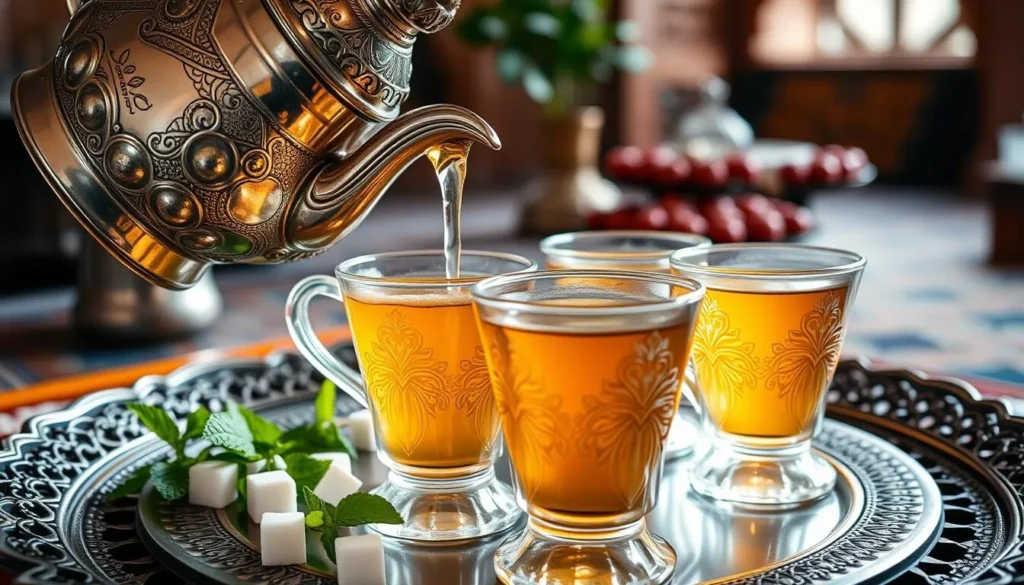
Traditional Moroccan mint tea being poured from height into decorative glasses
Language
Arabic and Berber (Amazigh) are Morocco’s official languages, but French is widely spoken in cities and tourist areas. English is increasingly common in tourist destinations but less so in rural areas. Learning a few basic Arabic or French phrases will be appreciated by locals:
- Hello: Salam alaikum (Arabic) / Bonjour (French)
- Thank you: Shukran (Arabic) / Merci (French)
- Yes/No: Na’am/La (Arabic) / Oui/Non (French)
- How much?: Beshhal? (Moroccan Arabic) / C’est combien? (French)
Money Matters
The Moroccan dirham (MAD) is the local currency. It’s a closed currency, meaning you can only obtain it within Morocco. ATMs are widely available in cities and towns, and credit cards are accepted at larger establishments, though cash is preferred for small purchases and in souks.
Dress Code
Morocco is a Muslim country with conservative dress standards, especially outside tourist areas. Both men and women should dress modestly, covering shoulders and knees. Women may want to carry a scarf for visiting religious sites. In major cities and beach resorts, dress codes are more relaxed but still more conservative than in Western countries.
Safety
Morocco is generally safe for travelers, with low rates of violent crime. The main concerns are petty theft and scams in tourist areas. Use common sense precautions: be aware of your surroundings, avoid displaying valuable items, and use hotel safes for passports and extra cash. Women travelers may experience unwanted attention and should consider traveling with companions, especially at night.
Ready for Your Moroccan Adventure?
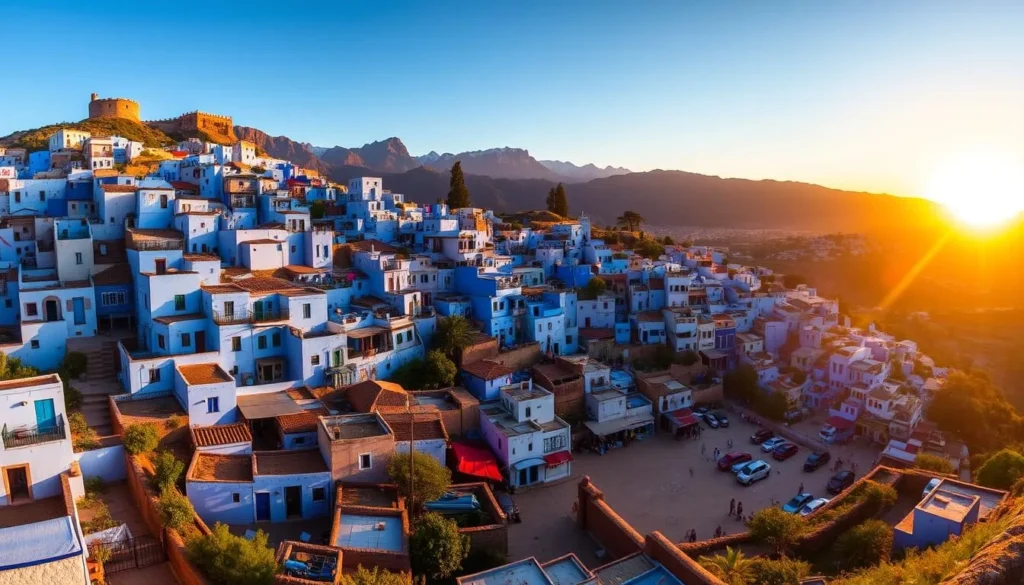
Sunset over the blue city of Chefchaouen nestled in the Rif Mountains
Morocco is a land of extraordinary diversity, where ancient traditions blend seamlessly with modern life. From the moment you step into a bustling medina, ride a camel across golden sand dunes, or sip mint tea with local Berbers in a mountain village, you’ll be captivated by the country’s unique charm and hospitality.
Whether you’re seeking cultural immersion, outdoor adventures, historical exploration, or simply a feast for your senses, Morocco delivers unforgettable experiences at every turn. The country’s manageable size makes it possible to experience desert, mountains, coast, and imperial cities all within a single trip, though you’ll undoubtedly want to return to discover more of its treasures.
Start Planning Your Moroccan Journey Today
From flights and accommodations to tours and activities, we can help you create the perfect Moroccan adventure.
Discover Activities
The above is subject to change.
Check back often to TRAVEL.COM for the latest travel tips and deals.
